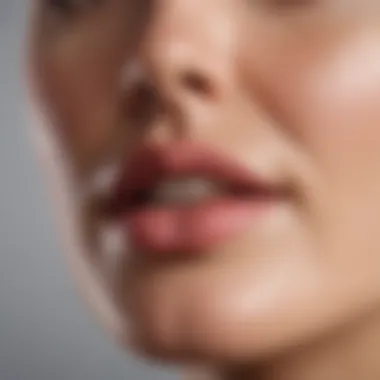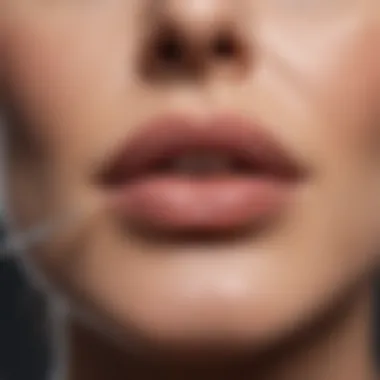Effective and Safe Methods for Upper Lip Hair Removal


Intro
Removing upper lip hair is a common concern for many individuals, especially women, who seek smooth skin without unwanted facial hair. This article delves into various methods of hair removal, combining effectiveness, skin sensitivity, and safety. With multiple techniques available, understanding the nuances of each can help make informed choices that suit personal grooming needs. This section will introduce the options available, focusing on methods like waxing, threading, shaving, and depilatory creams.
Trending Topics
Current Fashion Trends
Facial grooming has become an integral part of many fashion trends today. A clean and polished appearance is often associated with elegance and self-care. Women are increasingly paying attention to their beauty routines, ensuring that their upper lip is smooth. From Instagram influencers to high-profile models, the emphasis on facial hair removal is more visible now than ever. Trends shift, but the importance of personal grooming remains constant.
Beauty Innovations
The beauty industry is constantly evolving, introducing new products and techniques for hair removal. Innovations in skin care products now cater to those with sensitive skin, offering gentle yet effective solutions. Tools like electronic facial razors and natural depilatory creams are gaining attention because they claim to minimize irritation and provide convenience. Understanding these innovations equips users to select the best options for their skin type while removing hair safely.
Step-by-Step Guides
Fashion Styling Tips
When it comes to personal grooming, it’s not limited to hair removal itself. Consider how the removal method fits into an overall beauty regimen. Here are some tips to keep in mind:
- Always cleanse the skin before any hair removal process.
- Choose a method that complements your skin sensitivity.
- Maintain brows in conjunction with upper lip grooming for a balanced look.
Beauty Routines
Establishing a predictable beauty routine can enhance the results of any hair removal method. Here’s a simple outline:
- Preparation: Exfoliate the area two days prior to hair removal for smooth skin.
- Removal: Choose your preferred method, following manufacturer instructions carefully.
- Aftercare: Apply soothing ingredients post-removal, such as aloe vera gel or witch hazel, to calm any irritation.
Product Reviews
In-Depth Analysis of Popular Items
Selecting the right products can profoundly affect the hair removal outcome. Some commonly used choices include:
- Nad's Facial Wax Strips: Known for efficacy with minimal irritation.
- Schick Hydro Silk TrimStyle Razor: A versatile tool for shaving and maintaining skin health.
- Nair Hair Removal Cream: Popular among those seeking a quick and painless option.
Comparative Reviews
When comparing methods, consider the following factors:
- Effectiveness: How well does it remove hair?
- Skin Sensitivity: Does it cause any adverse reactions?
- Longevity: How long does the effect last?
Choosing an effective method, tailored to individual needs, can lead to a satisfying grooming experience.
Prolusion
The removal of upper lip hair is a subject of practical importance for many women across diverse backgrounds. While the aesthetic reasons for pursuing this practice are well understood, it also involves considerations of skin sensitivity, personal comfort, and hygiene. Many women seek guidance on how to navigate the various hair removal options available, striving for methods that balance effectiveness with safety.
In today’s world, personal grooming is often connected to one's sense of identity and empowerment. Thus, it becomes essential to approach upper lip hair removal with care and knowledge. Understanding the implications of different methods, from waxing to laser treatments, can help each individual choose the option that best suits their skin type and lifestyle.


Many factors contribute to the decision-making process in hair removal. For instance, cultural norms often influence preferences or methods, while personal experiences guide the choice of technique. Additionally, the consequence of skin irritation or allergic reactions cannot be overlooked. In this article, we will explore various removal methods, consider their safety profiles, and discuss post-removal care options. This comprehensive guide aims to furnish women with the tools required to make informed choices about this aspect of grooming.
Why Upper Lip Hair Removal Matters
The removal of upper lip hair is a topic that carries significance for many individuals. Understanding why this practice matters extends beyond mere aesthetics; it involves cultural perceptions, individual self-esteem, and overall grooming habits. This section delves into these critical aspects, providing readers with a nuanced view of why upper lip hair removal is relevant in today's society.
Cultural Perspectives
Cultural attitudes toward upper lip hair vary widely across different societies. In many cultures, smooth skin is associated with beauty and femininity. For some women, having visible upper lip hair may evoke unwanted attention or judgments, pressuring them to engage in removal practices. Conversely, there are cultures that embrace natural beauty, viewing body hair as a sign of authenticity.
Ultimately, societal norms play a crucial role in shaping how individuals perceive upper lip hair. Women navigating these cultural landscapes often find themselves grappling with conflicting messages about beauty standards. Understanding these dynamics allows for informed choices about hair removal. It encourages women to consider not just aesthetic preferences, but also cultural implications related to their grooming choices.
Personal Grooming as Empowerment
Personal grooming goes beyond routine maintenance; it serves as a form of self-empowerment for many individuals. Choosing to remove upper lip hair can impact how a person feels about themselves. This act can enhance confidence and self-image. When individuals take control of their personal grooming, they often experience a boost in their overall well-being.
Moreover, comprehending the techniques available for upper lip hair removal can help women align their grooming practices with their identities. For example, selecting a method that suits their lifestyle or skin type is an informed decision. This reinforces a sense of autonomy and self-care.
In summary, upper lip hair removal is not just about achieving a certain look; it is about understanding personal preferences influenced by culture, confidence, and empowerment. This awareness bridges the gap between societal expectations and personal choice, enabling women to navigate beauty practices that resonate with their individual values.
Overview of Hair Removal Methods
Understanding the various methods for upper lip hair removal is crucial for individuals seeking effective solutions that align with their skin type and lifestyle. This section presents a range of methods that cater to different preferences and needs. Among the primary techniques are waxing, threading, shaving, depilatory creams, and laser hair removal. Each of these methods has its benefits and considerations.
When exploring hair removal techniques, it helps to look at factors such as effectiveness, potential side effects, duration of results, and safety for your skin type. By evaluating these aspects, individuals can make informed decisions that suit their requirements. Below, each method will be examined in detail, providing clarity on their attributes and suitability.
Waxing
Type of wax
Waxing is a popular method due to its effectiveness in removing hair from the root. There are different types of wax, including hard wax and soft wax, each chosen based on personal preference and skin sensitivity. Hard wax often adheres to the hair rather than the skin, making it a gentler option for sensitive areas like the upper lip. Users find that it results in less irritation, making it a favored choice for many.
Pain tolerance
Pain tolerance varies by individual, and it greatly affects the perception of waxing. Generally, waxing does cause some discomfort as it removes hair swiftly. However, many find the discomfort manageable compared to the results achieved. The pain diminishes with regular use as the hair texture may change over time.
Results duration
The duration of results from waxing can be attractive. Typically, the hair does not regrow for about three to six weeks, depending on personal hair growth cycles. This extended period without hair regrowth makes waxing appealing for those looking to minimize upkeep.
Threading
Technique description
Threading is an ancient method of hair removal. It involves using a twisted thread to grasp and pull out hair from the follicle. This technique offers precise hair removal, ideal for shaping the upper lip area. Many prefer it for its proficiency and the absence of chemical substances which might irritate the skin.
Suitability for sensitive skin
Threading is regarded as skin-friendly because it does not involve harsh chemicals or hot wax. This makes it a suitable option for individuals with sensitive skin or those prone to allergic reactions. The method allows for a gentle approach to shaping without much irritation.


Precision vs. speed
When considering threading, precision is a key characteristic. It is particularly effective in shaping and defining the upper lip area. However, threading can be slower compared to waxing, possibly leading to a longer appointment time. Individuals must weigh the importance of precision and speed based on their needs and schedules.
Shaving
Tools used
Shaving has emerged as a convenient option for hair removal. Common tools include regular razors and specific facial hair razors designed for sensitive areas. These tools provide a straightforward method for quick hair removal at home, which can be appealing for those with busy lifestyles.
Potential risks
Although shaving is simple, it entails risks such as cuts, nicks, and skin irritation. Proper techniques and careful selection of shaving tools can mitigate potential hazards. Users should always ensure their blades are sharp and clean to minimize these risks.
Skin preparation
Preparing the skin before shaving is critical. It is advised to cleanse the area and apply shaving cream or gel to ensure a smooth glide of the razor. Skin preparation helps reduce irritation and promotes a better hair removal experience overall.
Depilatory Creams
Chemical composition
Depilatory creams work by breaking down hair structure with chemicals, making it easy to wipe away. Ingredients vary across brands, and vigilance is necessary to choose a formula that aligns with one's skin type. Checking for the presence of harsh chemicals is essential to avoid unwanted reactions.
Application process
The application process is generally swift. Users apply the cream to the skin and leave it on for a specific duration before wiping it off. Despite its ease, following the instructions closely is crucial to prevent adverse effects.
Skin compatibility
A significant consideration is skin compatibility. Not all creams suit every skin type. It is advisable to do a patch test before full application to ensure no allergic reactions occur. Doing so protects the skin from discomfort and rashes.
Laser Hair Removal
Effectiveness for long-term results
Laser hair removal is acknowledged for providing long-term results. This method targets hair follicles with concentrated light, resulting in significant hair reduction over multiple sessions. Many view it as a worthwhile investment given the lasting effects it can offer, though it may require commitment.
Cost considerations
Cost is a notable aspect of laser hair removal. While it tends to be more expensive upfront compared to other methods, the long-term benefits may justify the costs for some individuals. Understanding pricing and finding a reputable clinic are important considerations before proceeding.
Skin type suitability
Laser hair removal is not universally effective for all skin types. Individuals with lighter skin and darker hair often achieve the best results. Consulting with a professional to assess suitability is advisable to ensure safety and effectiveness.
Evaluating Safety in Hair Removal Techniques
When it comes to removing upper lip hair, safety should be at the forefront of decision-making. The skin on the upper lip is sensitive, and improper techniques can lead to various complications. This section will delve into critical elements of safety regarding hair removal methods. Understanding these components not only assures skin health but also contributes to effective and long-lasting results. Evaluating safety techniques can help avoid negative experiences and maintain the delicate balance of personal grooming.


Understanding Skin Sensitivities
Different individuals have varying skin types, and these differences can influence how the skin reacts to hair removal methods. For example, sensitive skin may experience redness, swelling, or irritation more easily than normal skin. Therefore, it is essential to recognize personal skin characteristics before opting for a specific removal technique.
Pay attention to signs of sensitivity, such as itchiness or burning. Those with a history of skin issues, such as eczema or rosacea, should proceed cautiously and perhaps consult a dermatologist for tailored advice. Optimal choices for sensitive skin may include threading, which is generally gentler, or shaving with suitable tools designed for delicate areas.
Allergic Reactions and Patch Testing
Allergic reactions to hair removal products can occur, posing a significant safety risk. Symptoms may include hives, redness, or blistering. To reduce the risk of such reactions, it is advisable to always conduct a patch test, especially when using new products like depilatory creams. This simple process involves applying a small amount of the product on a discreet area of skin to check for any adverse reactions.
If irritation occurs, it is crucial to stop using the product immediately and consult with healthcare professionals. Furthermore, individuals should read ingredient labels carefully, especially if they have a history of allergies.
"Always opt for patch testing before using new hair removal products to avoid potential allergic reactions."
Infection Risks
Infection is another concern associated with improper hair removal techniques. Bacterial contamination can occur, particularly with methods that break the skin, such as waxing or shaving. To mitigate infection risks, following proper hygiene is essential. Use clean, sterilized tools and ensure that the skin is prepped and clean.
After hair removal, the skin may be more susceptible to bacteria. Using soothing products like aloe vera or witch hazel can help calm the skin and reduce the risk of infections. Learning about the technique will help ensure that every session remains safe and effective while minimizing potential damage to the skin.
By prioritizing safety in hair removal practices, one can maintain healthy skin and achieve desirable grooming results.
Post-Removal Care
Post-removal care is a critical aspect of any upper lip hair removal routine. After hair removal, the skin is often sensitive and may require special attention to promote healing and maintain skin health. Proper post-removal care ensures that the skin recovers effectively, minimizing irritation and preventing adverse reactions. Taking the time to apply the right products and techniques can enhance the results of hair removal, while also providing comfort and protection to the delicate skin of the upper lip.
Soothing Products and Techniques
To mitigate any discomfort after hair removal, selecting the right soothing products is essential. Aloe vera gel is a popular choice, known for its natural soothing properties. It helps calm the skin and reduces redness that may occur post-removal. Additionally, applying a fragrance-free moisturizer can keep the skin hydrated, aiding in recovery.
Here are several effective soothing products and techniques:
- Cold compress: Applying a cold compress can help alleviate immediate redness and swelling after hair removal. The cold temperature constricts blood vessels, providing instant relief.
- Chamomile lotion: Using a lotion infused with chamomile can provide a calming effect. It is gentle and effective for sensitive skin.
- Tea tree oil: With its antibacterial properties, diluted tea tree oil can be applied to prevent infections while also soothing the skin.
Using these products and techniques can promote comfort and protect the skin integrity post-treatment.
Avoiding Irritation
Irritation can occur after hair removal for various reasons, including the method used or individual skin sensitivity. To avoid irritation, it is crucial to consider a few key practices:
- Patch test: Before trying a new product or method, conduct a patch test on a small area of skin. This will help identify any allergic reactions or sensitivities.
- Gentle cleansing: Use a mild cleanser when washing the face. Avoid harsh soaps that can strip the skin of its natural barriers and exacerbate irritation.
- Skip makeup: After hair removal, it is advisable to avoid makeup for at least 24 hours. Makeup products can clog pores and lead to further irritation.
- Sun protection: Protecting the skin from UV exposure is vital after hair removal. Use a broad-spectrum sunscreen with an SPF of at least 30 to shield exposed skin.
By implementing these precautions, one can significantly reduce the likelihood of post-removal irritation and help maintain healthy skin.
End
Choosing an appropriate method does not only influence the immediate results but also the long-term health of your skin. For example, while waxing might provide smoother results for an extended period, it could potentially irritate sensitive skin. On the other hand, methods like shaving are often less painful but may lead to quicker regrowth.
Choosing the Right Method for You
When it comes to selecting the right hair removal method, consider the following factors:
- Skin Sensitivity: Assess how your skin reacts to different products. For sensitive skin, threading or depilatory creams formulated for sensitive areas could be advantageous.
- Desired Results: If longer-lasting results are a priority, waxing or laser hair removal might suit your preferences better than shaving.
- Pain Tolerance: Different methods come with varying levels of discomfort. Understanding your pain tolerance can help narrow choices.
- Budget: Cost is a significant consideration. Methods like shaving and depilatory creams are generally more budget-friendly than laser treatments, which can be expensive.
Ultimately, the safest way to remove upper lip hair is the method that aligns best with your skin type, lifestyle, and grooming goals. Prioritizing safety, effectiveness, and comfort will empower you to make informed decisions, helping to enhance your personal grooming routine.



